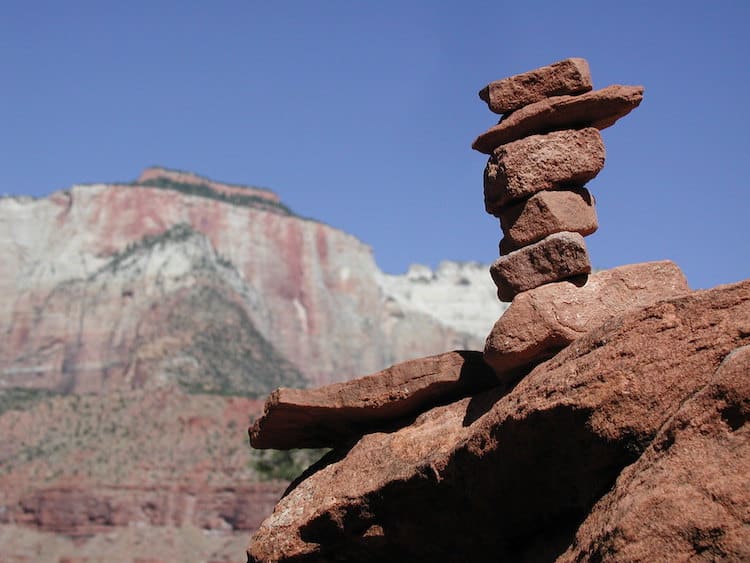
Photo: Veisha Flickr (CC BY-NC-ND 2.0)
If you’ve ever been on a hiking trail and seen a manmade stack of rocks, then you’ve encountered a cairn. Since prehistoric times, humans have stacked rocks as waymarkers or memorials. Scotland, in particular, is rife with cairns and, in fact, the word comes from the Gaelic word càrn meaning “heap of stones.” In more modern times, cairns have been used to mark trails and mountains, help give directions, and even provide wind shelters.
But, people are increasingly building their own cairns without understanding their true purpose, and this is cause for concern. Sometimes celebrated as a zen practice, building cairns can have consequences. By adding cairns to trails without any consideration, it’s possible to confuse hikers who use the rock stacks as directional markers. They can also disturb the environment, robbing the animals who live under the rocks of their shelter. The practice can also dislodge plants and inadvertently cause soil erosion. At the same time, it’s also not wise to add to or knock over existing cairns, as you might confuse hikers who used authorized rock stacks as directional markers.
For these reasons, it’s technically illegal to practice rock stacking in National Parks. “While not always widely enforced, rangers consider these stacks to be ‘rock graffiti‘ and will take them down when they’re spotted or discourage visitors caught building them,” notes the Zion National Park hiking guide. All parks take a “leave no trace” stance. They ask visitors to leave the natural environment exactly as they found it, without adding or taking anything away.
But if you are curious about cairns and how they’re used for navigation, there are many places where you can see them in action. One of the most well-known is Acadia National Park in Maine. The park has historically significant rock stacks known as Bates cairns. Created in 1896 by Waldron Bates, author of the park’s hiking maps, the carins are unique stacks with two small rocks placed with a space between them and a long rock stack on top like a bridge. Rangers continue to maintain these special cairns today and they are used for navigation.
Cairns are also used to help hikers in particularly remote areas of the Carlsbad Caverns National Park and Hawaiʻi Volcanoes National Park, where they are called ahu. Staff at the parks recommend speaking to the rangers if you want more information on how to use cairns for navigation or want clarity about whether or not trails are marked by official cairns. Some parks, like Capital Reef Park in Utah, don’t use them. And so you’ll want to be well informed before setting off on a trail.
So, while rock stacking has become a popular Instagram phenomenon, it’s important to understand the true history and meaning behind these structures. As a rule of thumb, if you come across a rock stack on your next hike, it’s best to just leave it be—no adding, subtracting, or knocking over.
Cairns have been used since prehistoric times as waymarkers, but you should take care not to create your own.

Photo: fthuerig/Depositphotos
Related Articles:
Hilarious One Star Yelp Reviews of Gorgeous National Parks
National Park Service Designs Hilarious PSA Poster About Bear Safety
Georgia Introduces All-Terrain Wheelchairs That Are Free To Use at State Parks
Yellowstone Park Reminds Visitors To Stay Away From Animals After Two Bison Attacks in Three Days
